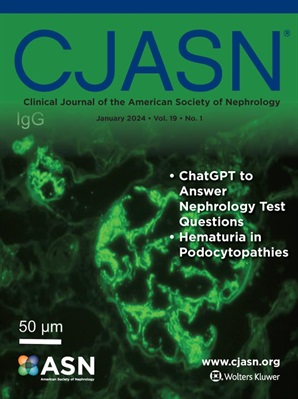Multicenter Development and Validation of a Multimodal Deep Learning Model to Predict Moderate to Severe Acute Kidney Injury.
IF 8.5
1区 医学
Q1 UROLOGY & NEPHROLOGY
Clinical Journal of the American Society of Nephrology
Pub Date : 2025-04-15
DOI:10.2215/cjn.0000000695
引用次数: 0
Abstract
BACKGROUND Prior models for the early identification of acute kidney injury (AKI) have utilized structured data (e.g., vital signs and laboratory values). We aimed to develop and validate a deep learning model to predict moderate to severe AKI by combining structured data and information from unstructured notes. METHODS Adults (≥18 years) admitted to the University of Wisconsin (2009-20) and the University of Chicago Medicine (2016-22) were eligible for inclusion. Patients were excluded if they had no documented serum creatinine (SCr), end-stage kidney disease, an admission SCr≥3.0mg/dL, developed ≥Stage 2 AKI before reaching the wards or intensive care unit (ICU), or required dialysis (KRT) within the first 48 hours. Text from unstructured notes was mapped to standardized Concept Unique Identifiers (CUIs) to create predictor variables, and structured data variables were also included. An intermediate fusion deep learning recurrent neural network architecture was used to predict ≥Stage 2 AKI within the next 48 hours. This multimodal model was developed in the first 80% of the data and temporally validated in the next 20%. RESULTS There were 339,998 admissions in the derivation cohort and 84,581 in the validation cohort, with 12,748 (3%) developing ≥Stage 2 AKI. Patients with ≥Stage 2 AKI were older, more likely to be male, had higher baseline SCr, and were more commonly in the ICU (p<0.001 for all). The multimodal model outperformed a model based only on structured data for all outcomes, with an area under the receiver operating characteristic curve (95% CI) of 0.88(0.88-0.88) for predicting ≥Stage 2 AKI and 0.93(0.93-0.94) for receiving KRT. The area under the precision-recall-curve for ≥Stage 2 AKI was 0.20. Results were similar during external validation. CONCLUSIONS We developed and validated a multimodal deep learning model using structured and unstructured data that predicts the development of severe AKI across the hospital stay for earlier intervention.预测中重度急性肾损伤的多模态深度学习模型的多中心开发和验证。
背景:早期识别急性肾损伤(AKI)的模型使用结构化数据(如生命体征和实验室值)。我们的目标是开发和验证一个深度学习模型,通过结合结构化数据和来自非结构化笔记的信息来预测中度至重度AKI。方法入选美国威斯康星大学(2009- 2020)和芝加哥大学医学院(2016- 2022)的成人(≥18岁)。如果患者没有记录的血清肌酐(SCr),终末期肾脏疾病,入院时SCr≥3.0mg/dL,在到达病房或重症监护病房(ICU)之前发生≥2期AKI,或在最初48小时内需要透析(KRT),则排除患者。来自非结构化笔记的文本被映射到标准化的概念唯一标识符(gui)以创建预测变量,并且还包括结构化数据变量。使用中间融合深度学习递归神经网络架构预测未来48小时内≥2期AKI。这种多模式模型是在前80%的数据中开发的,并在接下来的20%中进行了暂时验证。结果衍生组和验证组分别有339,998例和84,581例入组患者,其中12,748例(3%)发展为≥2期AKI。≥2期AKI患者年龄较大,男性居多,基线SCr较高,且在ICU更常见(p<0.001)。在所有结果中,多模式模型优于仅基于结构化数据的模型,预测≥2期AKI的受试者工作特征曲线下面积(95% CI)为0.88(0.88-0.88),接受KRT的受试者工作特征曲线下面积(95% CI)为0.93(0.93-0.94)。≥2期AKI的精密度-召回曲线下面积为0.20。外部验证结果相似。我们开发并验证了一个多模态深度学习模型,该模型使用结构化和非结构化数据来预测住院期间严重AKI的发展,以便进行早期干预。
本文章由计算机程序翻译,如有差异,请以英文原文为准。
求助全文
约1分钟内获得全文
求助全文
来源期刊
CiteScore
12.20
自引率
3.10%
发文量
514
审稿时长
3-6 weeks
期刊介绍:
The Clinical Journal of the American Society of Nephrology strives to establish itself as the foremost authority in communicating and influencing advances in clinical nephrology by (1) swiftly and effectively disseminating pivotal developments in clinical and translational research in nephrology, encompassing innovations in research methods and care delivery; (2) providing context for these advances in relation to future research directions and patient care; and (3) becoming a key voice on issues with potential implications for the clinical practice of nephrology, particularly within the United States. Original manuscript topics cover a range of areas, including Acid/Base and Electrolyte Disorders, Acute Kidney Injury and ICU Nephrology, Chronic Kidney Disease, Clinical Nephrology, Cystic Kidney Disease, Diabetes and the Kidney, Genetics, Geriatric and Palliative Nephrology, Glomerular and Tubulointerstitial Diseases, Hypertension, Maintenance Dialysis, Mineral Metabolism, Nephrolithiasis, and Transplantation.

 求助内容:
求助内容: 应助结果提醒方式:
应助结果提醒方式:


